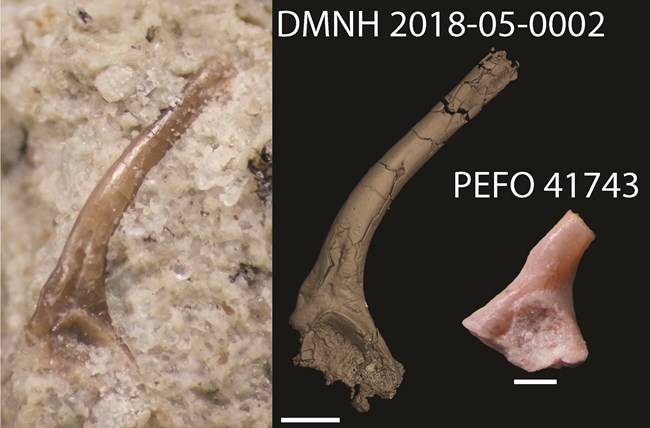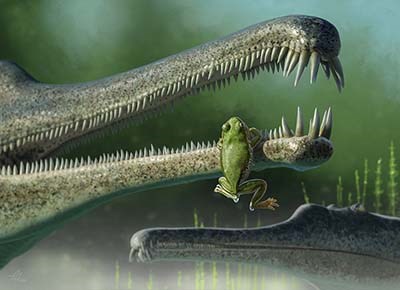Part of a series of articles titled Intermountain Park Science 2021.
Article
New Fossils Clarify the Early Evolution of Modern Frogs in North America
- Adam D. Marsh, Lead Paleontologist, Petrified Forest National Park, National Park Service

NPS Image.
The high desert grasslands of northern Arizona are not known as biodiversity hotspots for frogs, but there are more around than one might think. Summer monsoon rains at Petrified Forest National Park bring out a temporary frenzy of mating and foraging activity in Great Plains toads (Anaxyrus cognatus), Mexican (Spea multiplicata), Plains (Spea bombifrons) and Couch’s spadefoot toads (Scaphiopus couchii), Woodhouse’s toads (Anaxyrus woodhousii), and red-spotted toads (Bufo punctatus). These frogs (all toads are frogs, but not all frogs are toads) spend most of their time underground, but other frogs occur at Petrified Forest NP far beneath the dune sands that most modern frogs call home. These are fossil frogs from the Late Triassic Chinle Formation of Petrified Forest and adjacent lands in northern Arizona, and they are between 221 million and 213 million years old (Figure 1). The Triassic Period is the first of three periods in the Mesozoic Era, which is composed of the Triassic, Jurassic, and Cretaceous periods.
All modern amphibians belong to a group called Lissamphibia, which includes frogs, salamanders, and the legless caecilians (tropical amphibians that look like snakes). Because modern amphibians are more closely related to one another than to any extinct group of amphibians (Marjanović and Laurin 2007), taxonomists can use shared genetic information, rates of mutations in lissamphibian genomes, and the age of fossil lissamphibians to calculate the divergences of each evolutionary lineage. Such divergence estimations suggest a Triassic origination for the earliest true frogs (Feng et al. 2017), which is supported by the new frog from the Chinle Formation of Arizona, USA, and slightly earlier frogs from what are now Madagascar (Piveteau 1936; Rage and Roček 1989; Ascarrunz et al. 2016) and Poland (Evans and Borsuk−Białynicka 1998, 2009). The new frog fossils from Petrified Forest National Park and neighboring lands represent the earliest frogs in North America, as well as the earliest frogs from the equatorial region worldwide (owing to plate tectonics, Petrified Forest National Park was close to the equator during the Triassic; Stocker et al. 2019; see in reconstruction of Pangea in Figure 1).

Silhouette by Nobu Tamura via phylopic.org used under the Creative Commons Attribution 3.0 Unported license (https://creativecommons.org/licenses/by/3.0/).
Until these new frogs were discovered, the only amphibians from the Chinle Formation in Arizona belonged to the Metoposauridae, a long-extinct group of large-bodied, flat-headed ambush predators in Late Triassic lakes and rivers (Fig. 2A). Metoposaurids superficially looked like the giant Japanese salamander (Andrias japonicus), but the similarities are skin-deep. The skeletons of metoposaurids and lissamphians such as frogs are quite different, which makes them easy to tell apart when paleontologists are studying fragmentary skeletons or a single bone. The shape of the tiny ilium (one of the bones in the hip, plural is ‘ilia’) of early fossil frogs is distinctive (Figure 2B), which is what excited researchers from Virginia Tech and Petrified Forest National Park in 2018 when one appeared to be coming out of a siltstone rock collected on a ranch adjacent to Petrified Forest National Park (Figure 3; Stocker et al. 2019).

NPS Petrified Forest National Park (PEFO 41713), and Michelle Stocker, Virginia Tech (DMNH-2018-05-0002).
The 213 million-year old (Ramezani et al. 2011) fossil in rock was carefully wrapped in tissue paper and driven back to Virginia, where it was CT scanned in order to better study the anatomy of the extremely small fossil (less than 1 cm long; Yeh 2002). During that time, the research team also discovered similar ilia from different sites at Petrified Forest National Park and near St. Johns, Arizona (Figure 1), which are between 221 and 219 million years old (Atchley et al. 2013; Ramezani et al. 2014). Stocker et al. (2019) identified each of these ilia as belonging to a group within Lissamphibia called Salientia (modern frogs and their closest evolutionary relatives) because the ilia have long, hollow, forward-pointing shafts (Figure 2). These Chinle Formation frog ilia look more like the ilium of the younger Early Jurassic fossil frog Prosalirus bitis than older Early Triassic frogs; Prosalirus bitis is around 30 million years younger and occurs in the Kayenta Formation within the nearby Navajo Nation (Shubin and Jenkins 1995). Not enough anatomy of the Chinle Formation frogs is available to determine if they could have hopped like Prosalirus bitis and later frogs (Jenkins and Shubin 1998). The authors of the recent study (Stocker et al. 2019) also refrained from naming the new frogs until more fossils are found, which is only a matter of time. The new fossils are reposited at Petrified Forest National Park, the Perot Museum of Nature and Science in Dallas, Texas, and the Museum of Northern Arizona in Flagstaff.
One of the reasons early frogs are so elusive in the fossil record is because they were so small. A majority of the vertebrate fossils collected from the Chinle Formation and its Late Triassic age-equivalent strata in the southwestern United States (Arizona, Utah, New Mexico, Colorado, Wyoming, and Texas) are macrofossils; that is, they are discovered, excavated and studied using the naked eye. However, a recent emphasis on microfossils like these frog ilia (those fossils small enough to need magnification to see well) has introduced vertebrate paleontologists to a whole new component of Late Triassic ecosystems that was previously unknown. Collecting these fossils occurs by filling large buckets with rocks, soaking the rocks in water, and gently washing small fractions through various screen sizes before spending hours under the microscope picking out pieces of bones and teeth and reassembling them under the microscope. One specific microfossil locality at Petrified Forest, named after the abundant coprolites (fossil dung) found at the site, has produced fossils that were until recently only known from different time periods or different places around the world (Kligman et al. 2017, 2018; Stocker et al. 2019).

Art by Andrey Atuchin, used with permission.
In addition to providing support for the Triassic origin of true frogs (Stocker et al. 2019), these new fossil frogs tell an important story about how biological groups respond to climatic changes. Northern Arizona was much closer to the equator during the Late Triassic than it is now (the same relative latitude as modern day Costa Rica; Figure 1) and experienced seasonal wet periods (Zeigler and Geissman 2011). The sedimentary rocks and vertebrate fossils of the Chinle Formation were laid down by rivers, lakes, streams, and soils within floodplains and record a drying trend as the Late Triassic went onward (Figure 4; Atchley et al. 2013; Nordt et al. 2015). In addition, the hypothesized mass extinction at the end of the Late Triassic may have been the result of an increase in volcanism as North America began to separate from Europe before the Jurassic Period (Blackburn et al. 2013). The presence of anatomically similar frogs in the same region from the early part of the Late Triassic through the earliest Jurassic suggests that these frogs were not extirpated (did not become extinct from an area) during this volcanic drying period (Stocker et al. 2019).
This recent discovery is a great example of partnerships between university researchers and federal paleontologists, public lands and private landowners, and the museum institutions that care for and house fossils in perpetuity. These kinds of collaborations can bolster science programs in national parks, collect empirical data for use in resource management decisions, and provide a wide array of interpretive opportunities to the public about the vast paleontological resources protected by their federal lands. The new fossil frogs found at Petrified Forest National Park and neighboring lands may be small, as well as hundreds of millions of years old, but they tell a lot about the deep time history of living animal groups, the relationship between global climate and ecosystems, and how national parks play an important role within the scientific community.
The research article featured here can be read and downloaded for free at https://royalsocietypublishing.org/doi/10.1098/rsbl.2018.0922. (accessed January 15, 2021). A link to the CT scan data can be found in the open access paper. The work was funded by David B. Jones, the National Science Foundation, the Petrified Forest Museum Association, the Friends of Petrified Forest National Park, and the Virginia Tech Department of Geosciences.
References
Atchley, S. C., L. C. Nordt, S. I. Dworkin, J. Ramezani , W. G. Parker, S. R. Ash, and S. A. Bowring. 2013.
A linkage among Pangean tectonism, cyclic alluviation, climate change, and biologic turnover in the Late Triassic: the record from the Chinle Formation, southwestern United States. Journal of Sedimentary Research 83:1147-1161.
Ascarrunz, E., C.-C. Rage, P. Legreneur, and M. Laurin. 2016.
Triadobatrachus massinoti, the earliest known lissamphibian (Vertebrata: Tetrapoda) re-examined by µCT-scan, and the evolution of trunk length in batrachians. Contributions to Zoology 58:201-234.
Blackburn, T. J., P. E. Olsen, S. A. Bowring, N. M. McLean, D. V. Kent, J. Puffer, G. McHone, E. T. Rasbury, and M. Et-Touhami. 2013.
Zircon U-Pb geochronology links the end-Triassic extinction with the Central Atlantic Magmatic Province. Science 340:941-945.
Evans, S. E., and M. Borsuk−Białynicka. 1998.
A stem-group frog from the Early Triassic of Poland. Acta Palaeontologica Polonica 43:573-580.
Evans, S. E., and M. Borsuk−Białynicka. 2009.
The Early Triassic stem-frog Czatkobatrachus from Poland. Acta Palaeontologica Polonica 65:79-105.
Feng, Y.-J., D. C. Blackburne, D. Liang, D. M. Hillis, D. B. Wake, D. C. Cannatella, and P. Zhang. 2017.
Phylogenomics reveals rapid, simultaneous diversification of three major clades of Gondwanan frogs at the Cretaceous-Paleogene boundary. Proceedings of the National Academy of Sciences 114: E5864-E5870.
Jenkins, F. A. and N. H. Shubin. 1998.
Prosalirus bitis and the anuran caudopelvic mechanism. Journal of Vertebrate Paleontology 18:495-510.
Kligman, B. T., W. G. Parker, and A. D. Marsh. 2017.
First record of Saurichthys (Actinopterygii) from the Upper Triassic (Chinle Formation, Norian) of western North America. Journal of Vertebrate Paleontology 37: e1367304.
Kligman, B. T., A. D. Marsh, and W. G. Parker. 2018.
First records of diapsid Palacrodon from the Norian, Late Triassic Chinle Formation of Arizona, and their biogeographic implications. Acta Palaeontologica Polonica 63:117-127.
Marjanović, D., and M. Laurin. 2007.
Fossils, molecules, divergence times, and the origin of lissamphibians. Systematic Biology 56:369-388.
Nordt, L. C., S. C. Atchley, and S. I. Dworkin. 2015.
Collapse of the Late Triassic megamonsoon in western equatorial Pangea, present-day American Southwest. Geological Society of America Bulletin 127:1798-1815.
Piveteau, J. 1936. Une forme ancestrale des Amphibiens Anoures dans Trias inférieur de Madagascar. Comptes Rendus de l’Academie des Sciences 102:1607-1608.
Rage, J.-C., and Z. Roček. 1989.
Redescription of Triadobatrachus massinoti (Piveteau, 1936) an anuran amphibian from the Early Triassic. Palaeontolographica Abteilung A 206:1-16.
Ramezani, J., G. D. Hoke, D. E. Fastovsky, S. A. Bowring, F. Therrien, S. I. Dworkin, S. C. Atchley, and L. C. Nordt. 2011.
High-precision U-Pb zircon geochronology of the Late Triassic Chinle Formation, Petrified Forest National Park (Arizona, USA): temporal constraints on the early evolution of dinosaurs. Geological Society of America Bulletin 123:2142-2159.
Ramezani, J., D. E. Fastovsky, and S. A. Bowring. 2014.
Revised chronostratigraphy of the lower Chinle Formation strata in Arizona and New Mexico (USA): high-precision U-Pb geochronological constraints on the Late Triassic evolution of dinosaurs. American Journal of Science 314:981-1008.
Shubin, N. H. and F. A. Jenkins. 1995.
An Early Jurassic jumping frog. Nature 377:49-52.
Stocker, M. R., S. J. Nesbitt, B. T. Kligman, D. J. Paluh, A. D. Marsh, D. C. Blackburn, and W. G. Parker. 2019.
The earliest equatorial record of frogs from the Late Triassic of North America. Biology Letters 15: 20180922.
Yeh, J. 2002.
The effect of miniaturized body size on skeletal morphology in frogs. Evolution 56:628-641.
Zeigler, K. E., and J. W. Geissman. 2011.
Magnetostratigraphy of the Upper Triassic Chinle Group of New Mexico: implications for regional and global correlations among Upper Triassic sequences. Geosphere 7:802-829.
Last updated: July 12, 2021
